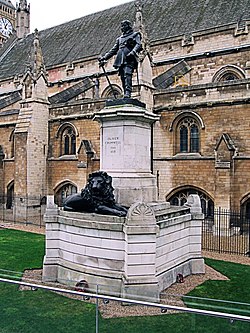Statue of Oliver Cromwell, Westminster
| Oliver Cromwell | |
|---|---|
 | |
| Year | 1899 |
| Type | Statue |
| Medium | |
| Subject | Oliver Cromwell |
| Location | London,SW1 United Kingdom |
| 51°29′59″N0°07′33″W/ 51.499788°N 0.125834°W | |
Astatue of Oliver Cromwellstands outside theHouse of Commons of the United KingdominWestminster,London.Oliver CromwellwasLord Protectorof theCommonwealth of England, Scotland and Irelandbetween 1653 and 1658. Directly opposite the statue, in the wall ofSt Margaret's Church,on the other side of the road, is a bust ofCharles I.
The statue was designed byHamo Thornycroftand erected in 1899. It has divided opinion, both before its erection and since, due to Cromwell's opposition to themonarchyand his role in theconquest of Ireland.
The statue is one of five public statues of Cromwell in the United Kingdom and isGrade IIlisted for its architectural merit.[1]
Description
[edit]The statue was sculpted byHamo Thornycroftand features Cromwell standing holding a sword and abible.[2]The bible is marked "Holy Bible 1641", and while the main statue of Cromwell is marked "Hamo Thornycroft 1897", the lion on the base is marked "1899".[3]
History
[edit]
Following the fire which destroyed parts of thePalace of Westminsterin the 19th century, the question whether or notOliver Cromwellshould have a statue in the reconstruction of the Palace was debated in the pages ofThe Times,andPunchmagazine satirised the issue.[4][5]The question was raised once more in the House of Commons in 1856, withJohn George Phillimoresaying "any man who could object to a statue of Cromwell must be imbued with bigotry and party spirit in the highest degree".[6]It was raised several more times over the following years by supporters of a statue.[7][8]
The government publicly proposed a statue of Cromwell for the first time in 1895, which immediately resulted in members of the public questioning the decision due to the divided opinions about Cromwell.[9]The proposal ended in a parliamentary debate and vote, in which the Government narrowly avoided defeat when theUnionistssided with them while the majority of theConservativesand theIrish National Partyvoted against the measure because of Cromwell'shistory in Ireland.[10]The decision was condemned by newspapers in Ireland.[11]Following further opposition from the Irish National Party, the proposal was withdrawn on 17 July 1895.[12]Herbert Gladstone,First Commissioner of Works,approved the statue with the funding coming from an anonymous private donor. In 1899 his successorAretas Akers-Douglasconfirmed the statue's proposed location as the sunken garden next to Westminster Hall.[13]The statue, cast in bronze bySingerof Frome, was unveiled on 31 October 1899, followed by a speech on Cromwell by former Prime MinisterLord Rosebery,[14]who was later revealed as the anonymous donor who paid for the statue, and whose wife was the sole heir to the Rothschild's family fortune.[2]
In 2004, a group of Members of Parliament proposed anearly day motionthat the statue should be removed and melted down. The move was not supported, and other MPs suggested that the statue should be moved somewhere else.[15][16]
Restoration work took place in August 2008, removing dirt and a coat of black wax which had been previously applied to the bronzework. This changed the colour of the statue from black to a more natural brown, and potassium sulphide was applied in order to even out the colour of both Cromwell and the lion. It was coated in a clear wax in order to ensure that the natural finish remained. The conservation work was completed in time for the 350th anniversary of Cromwell's death on 3 September 2008.[3]
See also
[edit]References
[edit]- ^Historic England,"Statue of Oliver Cromwell in front of Westminster Hall (1226285)",National Heritage List for England,retrieved5 February2016
- ^ab"TV review: Spectre of Cromwell still looms large".Sunday Business Post.14 September 2008.ProQuest818342238.(subscription required)
- ^ab"Cromwell conservation work".Parliament.uk.Retrieved2 August2012.
- ^"Cromwell online exhibition".The Cromwell Association.Retrieved2 August2012.
- ^Hutchinson, Peter (11 September 1845)."Should Cromwell Have a Statue?".The Times.No. 19026. p. 8.Retrieved2 August2012.(subscription required)
- ^"House of Commons".The Times.No. 22388. 7 June 1856. p. 6.Retrieved2 August2012.(subscription required)
- ^"House of Commons".The Times.No. 23690. 4 August 1860. p. 6.Retrieved2 August2012.(subscription required)
- ^"House of Commons".The Times.No. 23974. 2 July 1861. p. 6.Retrieved2 August2012.(subscription required)
- ^Smith, Goldwin (20 April 1895)."Cromwell's Statue".The Times.p. 8.Retrieved2 August2012.(subscription required)
- ^"Political Notes".The Times.No. 34604. 15 June 1895. p. 9.Retrieved2 August2012.(subscription required)
- ^"House of Commons".The Times.No. 34606. 18 June 1895. p. 6.Retrieved2 August2012.
- ^"Tercentenary Of Oliver Cromwell".The Times.No. 35813. 26 April 1899. p. 12.Retrieved2 August2012.(subscription required)
- ^"House of Commons".The Times.No. 35818. 2 May 1899. p. 6.Retrieved2 August2012.(subscription required)
- ^"Court Circular".The Times.No. 35942. 23 September 1899. p. 7.Retrieved2 August2012.(subscription required)
- ^"Oliver Cromwell statue moving".News of the World.16 May 2004. p. 29.ProQuest371884548.(subscription required)
- ^"Early Day Motions - Future of Cromwell Green".UK Parliament.11 May 2004.Retrieved14 February2023.
External links
[edit] Media related toStatue of Oliver Cromwell, Londonat Wikimedia Commons
Media related toStatue of Oliver Cromwell, Londonat Wikimedia Commons
- 1899 sculptures
- Bronze sculptures in the City of Westminster
- Grade II listed statues in the City of Westminster
- Grade II listed monuments and memorials
- Monuments and memorials in London
- Oliver Cromwell
- Outdoor sculptures in London
- Sculptures of lions in the United Kingdom
- Sculptures of men in the United Kingdom
- Sculptures of books
- Animal sculptures in London
